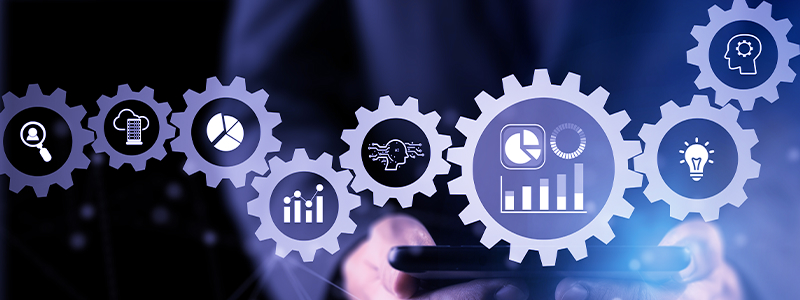
Healthcare Data Integration: Unify Data from Multiple Sources
Healthcare data integration is a critical component of modern healthcare systems. Combining data from disparate sources, such as EHRs and medical devices, allow providers to gain a complete picture of patient health and streamline workflows.
Let’s take a deep dive into the world of healthcare data integration and uncover the intricacies of this vital component of modern healthcare.

Data Integration Can Help The Healthcare Industry Enjoy Significant Savings
Learn how you can save time and money using Astera Data Pipeline Builder—a no-code data integration tool with built-in automation, scheduling and more.
Read Our Whitepapers!The Rise in Data Sources and the Importance of Healthcare Data Integration
The healthcare industry generates billions of terabytes of data from various sources. Electronic Health Records (EHRs) and Electronic Medical Records (EMRs) are primary sources of patient data. This data is mostly available in a structured format and easily accessible.
However, there are also secondary data sources, including telemedicine and insurance systems, pharmacy management systems, patient portals, social media, and more. The real task is to ingest, process, and consolidate this data and generate timely insights.
Healthcare data integration involves combining data from various touchpoints into a single, consolidated data repository. This data is cleansed and transformed during the process to be usable for reporting and analytics, so healthcare practitioners can make informed, data-driven decisions.

Healthcare Data Integration Use Cases
Here are some prominent use cases of healthcare data integration:
Patient-360 View
The patient-360 view is referred to a unified view of patient data that allows healthcare providers to gain a complete, holistic understanding of a patient.
This data may include, but is not limited to, a patient’s medical history, EHR records, insurance claims data, demographic data, lab results, and imaging systems. Healthcare organizations may also enrich this data with information from third-party providers.
A holistic view of the data in a unified platform enables healthcare practitioners to identify patterns and trends in patient behavior and, as a consequence, devise better diagnosis and preventative strategies as well as deliver personalized care.
Crisis Response
The COVID-19 pandemic highlighted the crucial role of health data integration in crisis response. Consolidated, high-quality data allows healthcare organizations to make informed crisis-response decisions—ensuring optimal care for patients and safety for frontline workers.
Healthcare organizations can quickly identify at-risk populations, track the spread of the virus, plan for effective vaccine distribution, and coordinate with other organizations to handle critical situations effectively.
Fraud Detection
Fraudulent activities in healthcare can take various forms, including identity fraud, where a patient uses multiple identities to access medical care; service-level fraud, such as overbilling for provided services; and insurance-level fraud, such as filing claims for services not received.
A single source of truth allows healthcare organizations to apply data mining techniques to effectively detect and prevent fraud.
Make Healthcare Data Integration Easy!
Astera Data Pipeline Builder allows you to speed up your data integration process while making it user-friendly. Try it for yourself!
Start Your FREE TrialData Integration Challenges in Healthcare
Healthcare data wields enormous power, but the sheer volume and variety of this data pose various challenges. Here are some data integration challenges that prevent healthcare professionals from unlocking valuable insights:
Data Silos and Lack of Interoperability
Data silos occur when data is stored in isolated systems that don’t communicate with one another. These silos are quite common—especially when healthcare providers use different EHR/EMR systems that are incompatible with each other.
Moreover, traditional, legacy systems make it difficult to integrate with newer, cloud-based systems, exacerbating the challenge of EHR/EMR data integration. The lack of interoperability among healthcare systems and providers is another aspect that makes real-time data sharing difficult.
Lack of Standardization
The lack of data standardization makes it difficult for healthcare providers to consolidate data from various sources. Data without standardization can result in duplicate records, system failure, and inaccurate insights, which can affect patient care.
The use of different data formats by healthcare providers hinders communication and data sharing between systems, which leads to and data quality issues. Lack of data standardization mainly affects data integration and reusability.
Data Privacy and Security
Medical providers face significant data privacy and security challenges when integrating healthcare data. Patient health information is highly sensitive and requires robust protection from unauthorized access and data breaches.
Healthcare systems increasingly rely on digital channels and collect data, so it’s imperative to maintain compliance with data privacy regulations. A 2022 report shows over 595 health data breaches occurred in the last three years, exposing over 40 million patient records.
Therefore, healthcare organizations must implement strict measures to protect confidential patient information while integrating data from various systems.

Best Practices for Seamless Healthcare Data Integration
Here are some data integration strategies to efficiently address healthcare data challenges:
Switch to a Cloud Data Warehouse
Cloud data warehouses are built to handle high data volumes and variety. A large cloud solution, such as Amazon Redshift and Snowflake, can serve as a centralized repository for high-velocity data streams.
Cloud data warehouses can offer more powerful computing capabilities for faster insights and improved business intelligence. Moreover, they are also easily scalable and offer unlimited storage capacity on the go.
Identify Data Sources
The key to successful data integration implementation is knowing where all critical data resides. For healthcare providers, EHR systems contain the most important data, but there are other data sources, internal and external, that must be identified and documented.
Implement Standards Such as FHIR and HL7
Using industry standards such as Fast Healthcare Interoperability Resources (FHIR) and Health Level Seven International (HL7) can facilitate the healthcare data integration process.
These standards provide a common language for data exchange, allowing healthcare organizations to share patient data easily.
Prioritize Data Privacy and Security
Robust security protocols and regular security audits are essential to ensure compliance with relevant data privacy laws and regulations such as Health Insurance Portability and Accountability Act (HIPAA) and General Data Protection Regulation (GDPR).
Looking for a Data Management Solution for Your Healthcare Organization?
At Astera, we're dedicated to fulfilling the healthcare industry's data management needs with our professional technical expertise and award-winning customer support.
Learn more about how we can help you!Transform Healthcare Data Integration with Astera
Astera Data Pipeline Builder is an enterprise-grade, end-to-end data integration platform that empowers you to seamlessly integrate healthcare data—without writing a single line of code. Using Astera Data Pipeline Builder, you can:
- Extract patient data from various disparate sources, transform it as per your requirements, and load it to a destination of your choice
- Connect with various third-party applications and databases using built-in connectors
- Validate healthcare data using data quality rules and advanced profiling capabilities
- Provide role-based access controls and encrypt data to ensure compliance with standard regulations, including GDPR and HIPAA.
- Connect to popular cloud platforms, databases, and data warehouses, like Amazon S3, Snowflake, and Microsoft Azure Blob Storage, using built-in connectors.
- Automate data integration jobs through scheduling and job orchestration capabilities
ADPB’s powerful, AI-driven features such as cloud-based data prep, semantic data mapping, and support for varying data latencies make it a valuable resource for healthcare data integration. Start benefiting from clinical insights today—download our 14-day trial now!
 Astera AI Agent Builder - First Look Coming Soon!
Astera AI Agent Builder - First Look Coming Soon!

